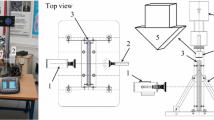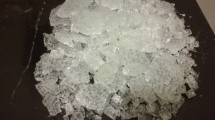Abstract
Techniques for obtaining controlled fractures in sheet glass by means of thermal stress are outlined. The velocity behavior of fracture under different stress configurations is analyzed, and it is seen that the nature of crack is strongly influenced by the ambient stress field. The peak velocity of a typical free-running fracture is observed to be 1450 m/sec and the corresponding crack opening to be 4 microns.
Similar content being viewed by others
References
Griffith, A. A., Phenomena of Rupture and Flow in Solids, Trans. Roy. Soc. (Lond.), Ser. A,221,163–198 (1920).
Yoffe, E. H., The Moving Griffith Crack, Phil. Mag.,42,739–750 (1951).
Shand, E. B., Experimental Study of Fracture in Glass: I, The Fracture Process, J. Am. Ceram. Soc.,37,52–60 (1954);Shand, E. B., Experimental Study of Fracture in Glass: II, Experimental Data, Ibid. J. Am. Ceram. Soc., 559–572.
Shand, E. B., Breaking Stress of Glass Determined from Dimensions of Fracture Mirrors, J. Am. Ceram. Soc.,42,474–477 (1959).
Shand, E. B., Strength of Glass-The Griffith Method Revised, J. Am. Ceram. Soc.,48,43–49 (1965).
Ord, P. R., Observations on Glass Cutting by Diamond, Soc. Glass Tech.,41,245–258 (1957).
Anderson, O. L., The Griffith Criterion for Glass Fracture, Fracture, Averback, Felbeck, Hahn andThomas Eds., J. Wiley & Sons, Inc., N. Y., 331–351 (1959).
Schardin, H., Velocity Effects in Fracture, Fracture, Averback, Felbeck, Hahn andThomas, Eds., J. Wiley & Sons, Inc., N. Y., 237–330 (1959).
Clark, A. B. J. andIrwin, G. R., Crack-Propagation Behaviors,Experimental Mechanics,6 (6),321–330 (1966).
Küppers, H., The Initial Course of Crack Velocity in Glass Plates, Intl. J. Fracture Mech.,3,13–19 (1967).
Rader, D., On the Dynamics of Crack Growth in Glass,Experimental Mechanics,7 (4),160–167 (1967).
Mohanty, B. B., Elastodynamic Studies of Brittle Fracture in Glass, Ph.D. Thesis, Department of Physics, Univ. of Toronto (unpublished) (1969).
Kerkhof, F., Ein einfacher Versuch zur Bruchflächenmarkierung durch Mechanische Impulse, Glastech. Ber.,27,57–58 (1954).
Kingery, W. D., Symposium on Thermal Fracture, J. Am. Ceram. Soc.,38,1–15 (1954).
Savage, J. C. andMansinha, L., Radiation from Tensile Fracture, J. Geophys. Res.,68,6345–6358 (1963).
Jaeger, J. C., Numerical Values for the Temperature in Radial Heat Flow, J. Math. Phys., 34, 316–321 (1955).
Ernsberger, F. M., Strength-controlling Structures in Glass, Tewksburry Symp. on Fracture, Melbourne Univ. (1965).
Author information
Authors and Affiliations
Rights and permissions
About this article
Cite this article
Mohanty, B.B. Some characteristics of thermal fracture in glass. Experimental Mechanics 12, 471–474 (1972). https://doi.org/10.1007/BF02328818
Received:
Revised:
Issue Date:
DOI: https://doi.org/10.1007/BF02328818




